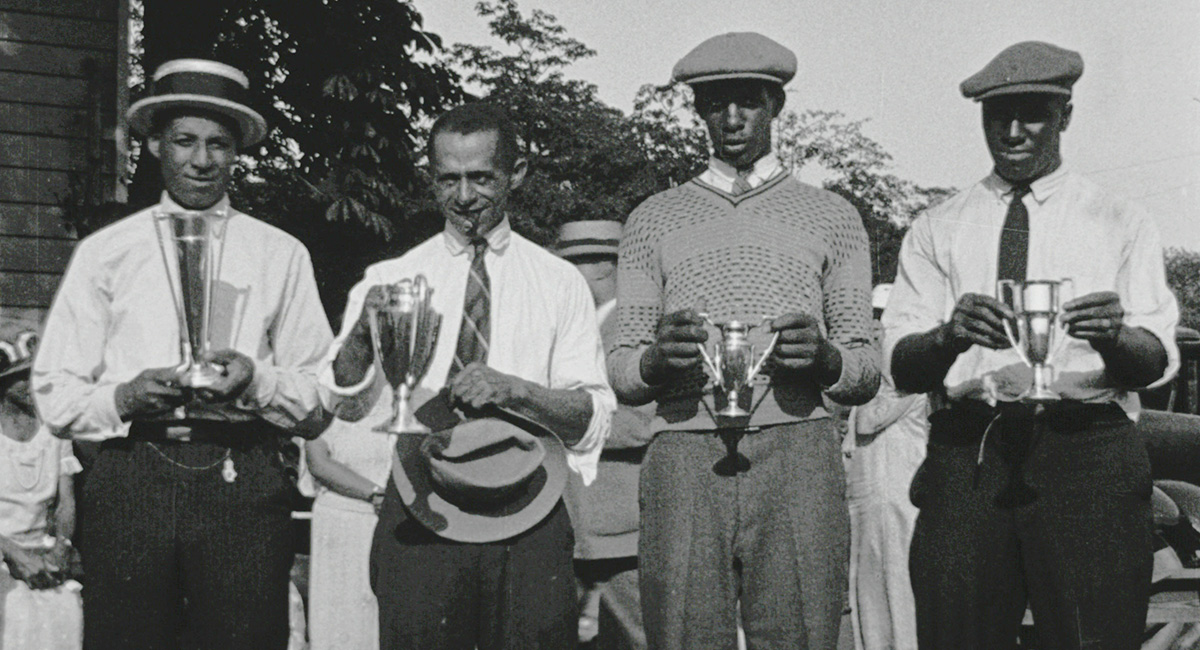Open History
UofSC holds only known film footage of first American pro golfer John Shippen
In 1896, John M. Shippen became the first American-born professional golfer when he played at the second U.S. Open at Shinnecock Hills Golf Club in New York. He was 16 and African-American.
In 1925, he finished second at the African American United Golfers Association tournament. The university’s Moving Image Research Collections (MIRC) has that footage in its Fox Movietone News Collection. It is the only known film of Shippen.
The 10-minute film is a compilation of outtakes shot at the tournament, which took place at Shady Rest Golf and Country Club in New Jersey, the first African-American country club in the U.S. In addition to players on the course, the film includes footage of Shippen receiving a trophy for his second place finish.
While there is no footage of Shippen playing golf, the film does feature Harry Jackson, who emerged as a legendary African-American golf champion in the 1920s and 30s. There’s also shots of caddies, club members socializing and women playing golf.
Bobby Donaldson, associate professor of history and director of the Center for Civil Rights History and Research, says the rare footage provides a window into multiple aspects of African-American life in the 1920s.
"The 1925 Shady Rest tournament attracted attention from African-Americans across the country who were interested in what was hailed as the ‘first National Colored Open Golf Championship,’” Donaldson says. “This fascinating footage showcases pioneering sports figures and provides us a literal window into African- American life and culture during the height of the Jazz Age."
Shippen worked the grounds as a teenager at the Shinnecock Hills golf club, before becoming a caddie and ultimately an expert golfer.
When he entered the 1896 U.S. Open at Shinnecock, the British and Scottish players threatened to boycott the event because Shippen and another player, Shinnecock Native American Oscar Bunn, were not white. U.S. Golf Association President Theodore Havemayer defended the two men, insisting that if the Brits and Scots didn’t drop their boycott, Shippen and Bunn would be the only two golfers playing in the tournament. Shippen placed sixth overall and went on to play five more U.S. Opens through 1913.

Greg Wilsbacher, curator of newsfilms at MIRC, says they knew the 1925 golf tournament footage was important when it was first cataloged in the 1980s. It wasn’t until 2002 when a staff member realized Shippen was among the players.
Wilsbacher, an expert in film and news history and conservation, says the Fox News cameramen’s approach to covering professional African-American athletes was remarkable.
“The fact that Fox covered this tournament in the manner they did during the Jim Crow-era speaks volumes,” Wilsbacher says. “They sent two of their top New York camera operators to shoot the tournament, and they got all the typical shots you’d expect to see of any major golf event — swings, putts, close-ups of the athletes’ faces and the awards ceremony. They didn’t make a spectacle of the game or manipulate events that transpired to produce a stereotype.”
While the original nitrate film footage of Shippen at the UGA game in 1925 is safely stored in a climate-controlled film vault, MIRC has taken steps to ensure it remains accessible to future generations. MIRC made a preservation-quality copy of the original film in the event the original film deteriorates. There is also digitized footage that is online for the world to see.
Fox used the footage of the 1925 tournament in its weekly newsreel to movie theaters nationwide, which showed the newsfilms before movies. This is how Americans were introduced to on-screen news.
The Shippen footage is still in use today. ESPN, the Smithsonian, Shady Rest Golf Course and public television as well as several authors have licensed the footage for documentaries, websites and research.
Tom McNally, dean of University Libraries and an avid golfer, says the outcome of the 1896 U.S. Open would be very different if played today.
“Shippen was very much in contention on the final day of the tournament. The reason he took an 11 on a hole in the final round was that he made a bad shot and ended up in the tire rut of a dirt road that ran along the course. In 1896, there was no such thing as a wedge, so he was forced to hit the ball along the rut until it got to a low point where he could hit out,” McNally says.
“With today's clubs, Shippen easily could have hit the ball out or taken an ‘unplayable lie,’ which is essentially when your ball lands somewhere you can’t reach, you can move the ball and take a penalty. Since the unplayable lie rule did not exist in 1896, that one bad shot cost Shippen a place in golf history. He most likely would have won the U.S. Open.”